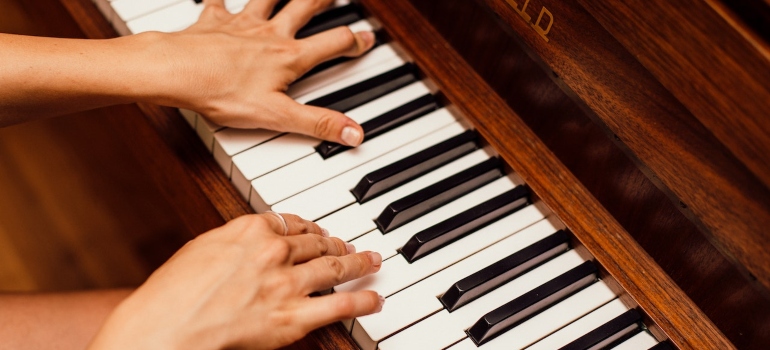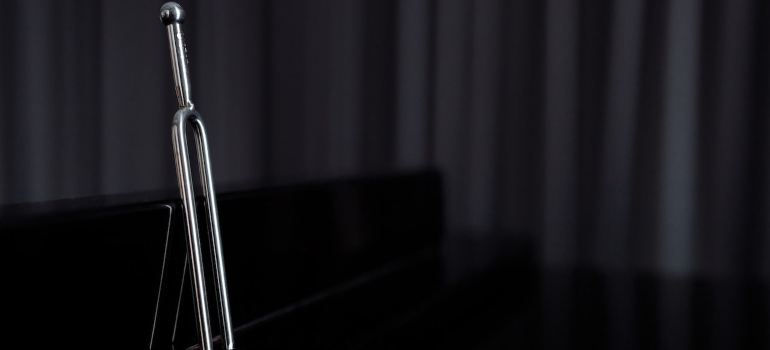Moving a piano can seem intimidating. However, with the right information, it is achievable. This guide is specially designed to help you navigate the process of moving your precious instrument. The importance of understanding the piano types, correct moving gear, and maintaining the piano post-move cannot be overstated. Therefore, this guide will serve as your comprehensive manual. While there are numerous moving companies DC area is home to, if you’re determined to move a piano without professional movers, your courage is commendable! Therefore, let’s walk through this journey together and ensure your piano arrives safely at its new home.
How to move a piano without professional movers – types of pianos
Understanding your piano type is a crucial first step. All pianos are put in two main groups.
Upright pianos are the most commonly used in homes
Upright pianos, named for their vertical design, range in size. Here are the different types:
- Spinet: This is the smallest type, lighter, and easier to manage.
- Console: Slightly larger, but manageable with careful handling.
- Studio: Known for their robust sound, they’re a bit taller.
- Full-size: These are the largest upright pianos, requiring more effort to move.
Grand pianos are the professional ones
Grand pianos, with their horizontal design, require additional considerations.
- Baby grand: The smallest of the grand pianos, but still hefty.
- Medium grand: A little larger, meaning more hands may be needed.
- Parlor grand: These pianos demand extra attention due to their size.
- Ballroom or semi-concert grand: Even larger, their move will be more challenging.
- Grand: The largest and most impressive, requiring utmost care.
However, with the right strategy, you can move your piano, be it a baby grand or full-size upright, without hiring professional movers. But, sometimes, things could get complicated. That is why it is a good idea to contact DC piano movers. It is always safer to have professionals move your heavy pianos.

Equipment and tools
Selecting the right tools can significantly ease your moving process.
- Piano dolly: This tool ensures your piano’s secure transportation while saving you from overexertion.
- Piano skid board: A must-have for grand pianos, it protects your instrument during the move.
- Moving blankets and straps: These will shield your piano from any potential scrapes and hold it in place during transport.
- Heavy-duty gloves: Your hands’ protection is important. These gloves also provide a more secure grip.

Safety gear
You should also invest in safety gear. It may seem minor but can be a major preventative measure:
- Non-slip footwear: Secure footing is key to safe maneuvering.
- Safety goggles: When lifting heavy objects, you never know what might fall. Better safe than sorry.
- Back supports: These are crucial for safe lifting and carrying.
By gathering the right gear, you’re taking a significant step towards moving your piano safely. However, the task is still challenging. Therefore, always consider your personal limits and the risk involved. In other words, it’s always wise to consider alternatives, like hiring reputable Washington DC movers, if the task becomes overwhelming.
What are the steps you need to take when you are moving a piano?
Moving a piano begins with meticulous planning. Understand the route from the piano’s current location to its destination. Are there stairs, narrow corridors, or sharp turns? Prepping the piano comes next, which includes securing the keyboard lid and, for a grand piano, disassembling parts like the pedal lyre and music rack. Wrap the piano in thick blankets for added protection. Then the lifting part. Ideally, this step includes extra hands. Clear communication is crucial – everyone should know their role, when to lift, set down, and adjust direction. Although the process of moving a piano is intricate and challenging, careful planning and patience can ensure a smooth and successful transition, safeguarding your precious instrument throughout the journey.
How to properly maintain your piano after transporting it
You’ve completed your move, and now your beloved instrument sits in its new home. So, what’s next? Here, we delve into crucial steps to maintain your piano post-move.
Placement
Your piano’s placement plays a crucial role in its longevity. Find a spot away from vents, fireplaces, windows, or any area with a drastic temperature change. That way you prevent its wood and soundboard from warping.
Tune up
Transport can detune your piano. Therefore, schedule a professional tuning after settling it in its new spot. This step will ensure the quality of sound remains intact.

Cleaning
Pianos collect dust and grime, especially during a move. However, avoid using any harsh cleaning chemicals. Instead, opt for a soft, damp cloth to gently clean the keys and a dry one for its body. This is one of the best ways you can properly clean your piano. That way you can maintain it for long.
Regular maintenance
Ensure your piano’s longevity with regular maintenance. Monitor its placement, tune it biannually, and maintain cleanliness. Plus, consider a professional inspection yearly. These simple steps can make your piano last for generations.
In addition, if moving your piano has proven too challenging, remember there are reliable options like Interstate Movers DC residents trust. They have the skills, equipment, and experience to handle such tasks efficiently.
In other words, moving a piano without professional movers requires a substantial amount of effort, both in the moving process and subsequent care. But with the right approach and commitment, your piano can thrive in its new home.
Why it isn’t a good idea to try to move a piano on your own
Pianos are not just heavy, they’re cumbersome, and one wrong move could lead to serious, potentially long-term harm. With its intricate internal mechanics and delicate exterior, a piano can easily suffer harm, which may result in costly repairs or even total loss. The fact is, moving a piano is a challenging task, even with all the necessary tools and knowledge. Pianos are built to create beautiful music, not for easy mobility. Professional movers have the experience, skills, and equipment necessary for this task. Their expertise can turn a nerve-wracking process into a seamless experience. Therefore, while it’s theoretically possible to move a piano without professional movers, the benefits of hiring professionals far outweigh the risks. With them, the beautiful music your piano produces won’t be marred by the sour note of a moving mishap.


